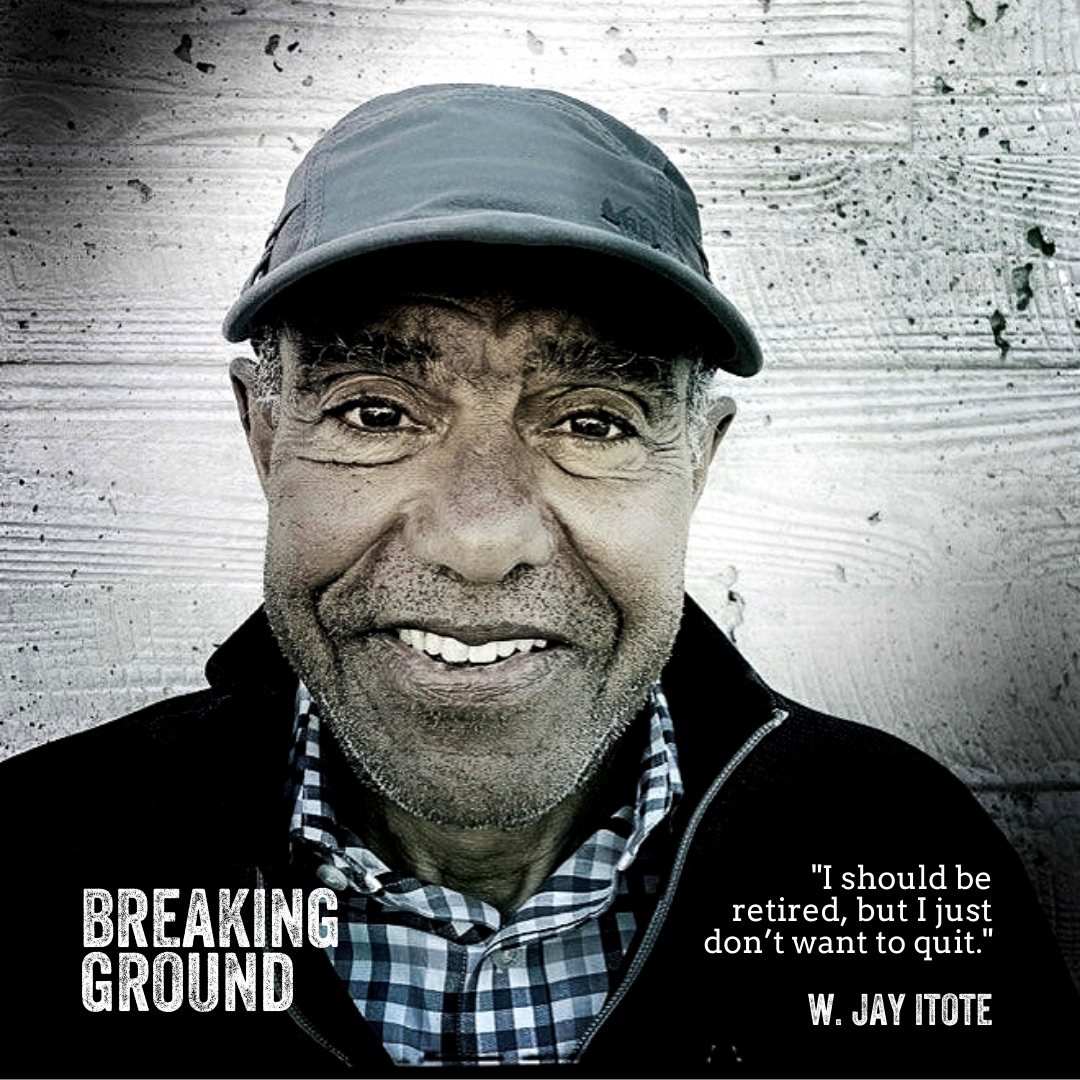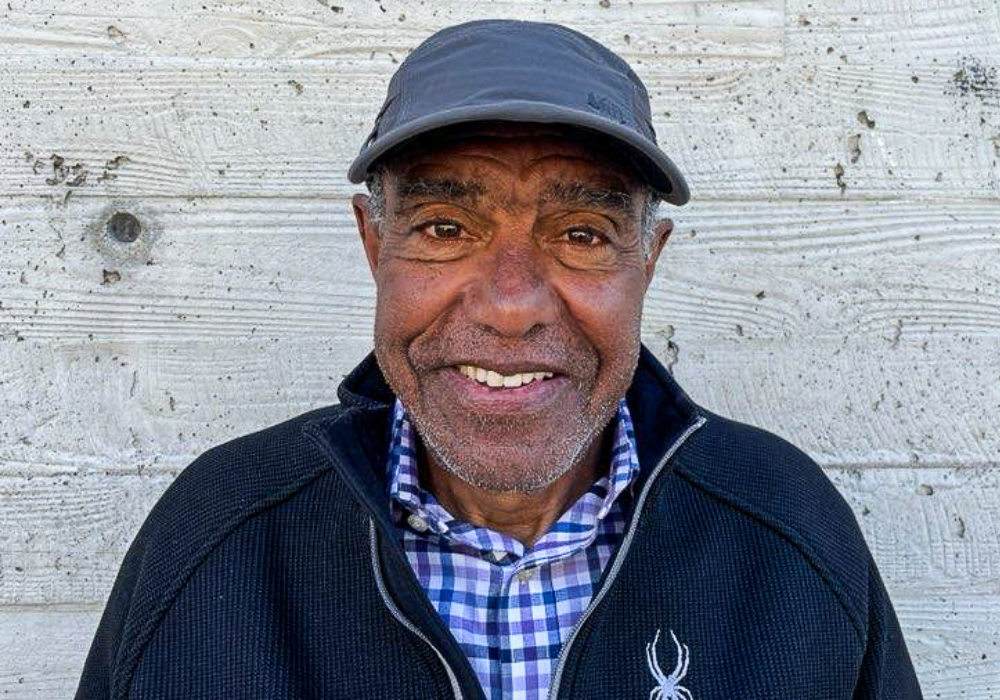“Debería estar jubilado, pero simplemente no quiero dejar.”
Meet Jay Itote, owner of Canyons Gate Vineyard in Selah, WA. While this is Jay’s first time growing grapes, it’s not his first foray into farming. Canyons Gate is actually his third farm. Before this, he had a farm in Goldendale, WA, and even one in Belize, where he lived for many years. Having spent 40 years as a civil engineer, Jay has a storied past. “I’m originally from West Chester, Pennsylvania, which is a small town outside of Philadelphia. It was actually the epicenter of the underground railroad. As small children, we played in a lot of the sites where slaves had sought shelter and where they would be transferred to the next conductor.” Jay brings a lifetime of learning to Washington and wine. “We’ve had plants in the ground since 2016, when we put our first blocks in. I don’t hide the fact that this is my first time growing grapes.”
I don’t profess what I don’t know. I don’t get out there and act like I know. It’s much more my style to say I’m new at this, I’m going to need some help.—Jay Itote, Canyons Gate Vineyard
Translated by Melany Meza
Washington Wine: Tell me a little bit about who you are and how you got to where you are right now.
Jay Itote: Well, I am a construction civil engineer by profession. I’ve been doing that for about 40 years. I’m originally from West Chester, Pennsylvania, which is a small town found at the end of what is called the Main Line Southwest of Philadelphia.
West Chester was the epicenter of the underground railroad during slavery. Not sure what the connection is but there is a line in the movie “Harriet,” in which Harriet Tubman is being told by a Black Quaker to contact a family with our family’s last name. During my childhood and until today, we were the only family in the area with that name. As children, we played at sites where slaves had sought shelter until they would be transferred to the next conductor in an effort to move deeper into the north. That little town was very rich in American history. It was 15 miles from the Mason Dixon line the division of the north and south. A lot of people don’t know that Pennsylvania is actually the separation of the North and the South, mostly because it’s 125 miles North of Washington DC.
I grew up in an attached three-story brick colonial house that had a stone marker inserted between the granite curb and red brick sidewalk that read, “General Lafayette spoke to his troops here in 1812.” Growing up, I interfaced with Quakers, Amish, and Mennonites. Most lived on farms in outlying communities. I attended Mennonite Bible Schools in the summer. West Chester and the history of that area of Pennsylvania has had a profound influence on me. The Underground Railroad and the abolitionist movement shaped my social justice consciousness. Our town was well-known as a place of refuge for slaves.
As a kid, I would see folks like Pearl S. Buck, the writer and novelist in this town of 11,000 people. Ms. Buck was awarded a Nobel Prize in Literature in 1938 for the Good Earth. My mother informed me that Ms. Buck lived in New Hope, Bucks Country, but would frequent West Chester due to family and friends. Artist Andrew Wyatt, who I first met and photographed at the Chadds Ford Post Office as a teenager, was super gracious to me whenever our paths would cross. Claude Rains, the actor who played in Casa Blanca and Lawrence of Arabia lived a block from my home. Samuel Barber, the world-renowned classical pianist, lived a stone’s throw from our back yard. Byard Rustin, the man who organized MLK’s March on Washington, would often appear in the barbershop owned his brother Earl, my childhood barber. It was also the home of Horace Pippin, the famous primitive artist.
My mother was the guiding light that taught me who these people were and what they did in life. She was also the one who taught me about cuisine. My mother and father had a small catering business. I often could be found making tea sandwiches and hors d’oeuvres. After an event, my mother would bring home strange foods like chocolate covered grasshoppers, ants, and other insects. For a 11-year-old African- American kid, these experiences helped shape my understanding about America and my place in it.
My mother was the guiding light that informed me as to who these people were and what they did in life. She was also the one who taught me about cuisine.—Jay Itote
My father had the most influence on me in respect to farming. He worked 7 days a week for most of the time I was growing up. He worked 5 days at the 3,000 bed Valley Forge Army Hospital in the food service. By the time he retired, he was the Superintendent of Food Service. The other two days, he worked at one of the first Black Angus Ranches in the Northeast. This ranch was near Gettysburg, Pa. I can tell you that as a child and teenager I saw a lot of Andrew Wyatt landscapes in real time roaming around the county with my father. My first farming experience happen at that Angus ranch. The owner allowed my father and other ranch hands to grow row crops on about two acres. During this period, I was first introduced to grapes. At the age of about nine my father installed a 20’x 30’ grape arbor in our back yard. I cannot remember the varietal, but it was a white wine grape that could survive the harsh east coast winters. That arbor became the center of all family summer gatherings after it was completed.
Now in 2022, I’m on my third farm with Canyons Gate Vineyard in Selah, WA. My first farm/ranching venture took place in Goldendale, WA which is about 60 miles from the vineyard. Back in the day and as far as I knew, I was the only Black man in the whole County of Klickitat.
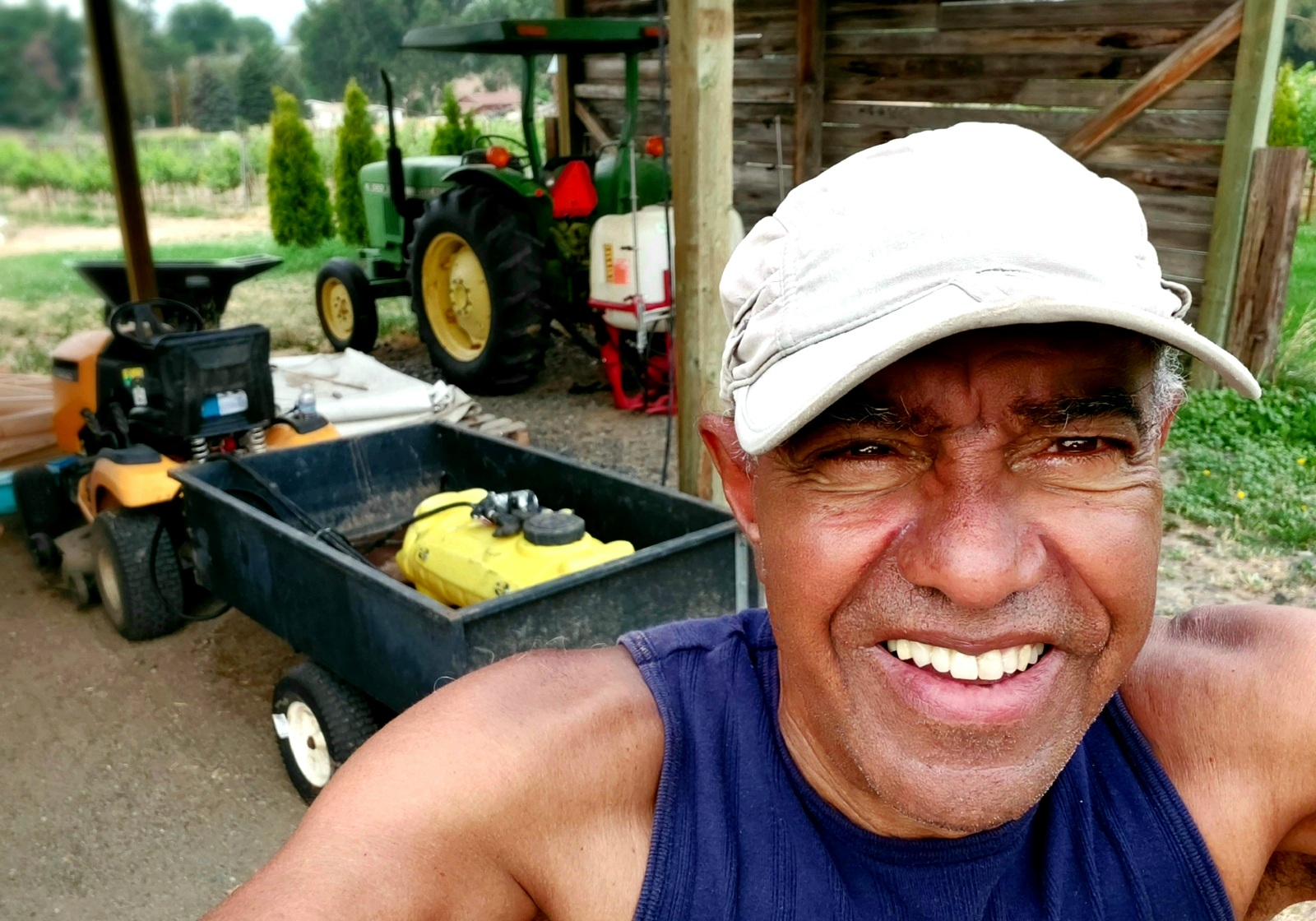
WW: What was, or is, that like? Being one of the few Black farmers?
Jay: It’s been quite interesting to be in that space. Farming on any level is hard work whatever race you are whether in Selah, Goldendale or Belize Central America. My neighbors saw that I was a relentless worker in whatever weather or situation. I felt comfortable in my own skin. White folks in general and particularly in farming regions have had no experience being around African Americans on any level. Even today, there’s so much stereotyping and negative energy that more often than not it creates a wall of fear that prevents good will and communications between folks of all races. With that said, I have some very rich memories of Goldendale, and I left there with a feeling that most people in Goldendale were good hearted folks, who would be there for you when needed. I truly felt Goldendale was one of the best places I’ve ever lived in. Also, living there introduced me to Yakima and Selah, where I would travel biweekly over Status Pass to buy equipment and supplies.
In Goldendale, I was homesteading. Learning my chops every day. Making mistakes but learning from them as well. My fondest memory was building a small cabin there with a chainsaw. In the end, I was only a half an inch off plumb on that structure. Prior to building the cabin I built a corral with feeding stations and stanchions for my 36 goats. Once, I was able to draw water from a seasonal creek, I planted organic barley, rye, oat, sunflowers, alfalfa, amaranth, and quinoa. Many of the grains you see are commonplace in the marketplace today.
At that time, I was aware of the farm subsidies available to small farmers in the area. However, the local USDA was not there for black farmers. It’s my opinion, but the USDA at that time could not wrap their head around the concept of African American farmers at least on the west coast. Some 20 years after my Goldendale adventures, the USDA settled a class action lawsuit with African American and Native American farmers for one billion dollar each for in essence red lining them. Today, with the vineyard we are working with the USDA to take advantage of their conservation and sustainability programs. Our goal is to protect what is there but also to develop as many streams of revenue as possible while considering the impact on habitat and the human communities. We are seeking technical and financial assistance from the local USDA. So far, being in this space now had been good. Systemwide, the problems rearing its head is the lack of diversity within the ranks of the regional USDA infrastructure. I would love to see more hiring from diverse groups.
After 7 years in Goldendale, I departed the Northwest for the life of farming and engineering in Belize, Central America. Goldendale was what I wanted it to be: a learning tool.
Back in the day and as far as I knew, I was the only Black man in the whole County of Klickitat.—Jay Itote
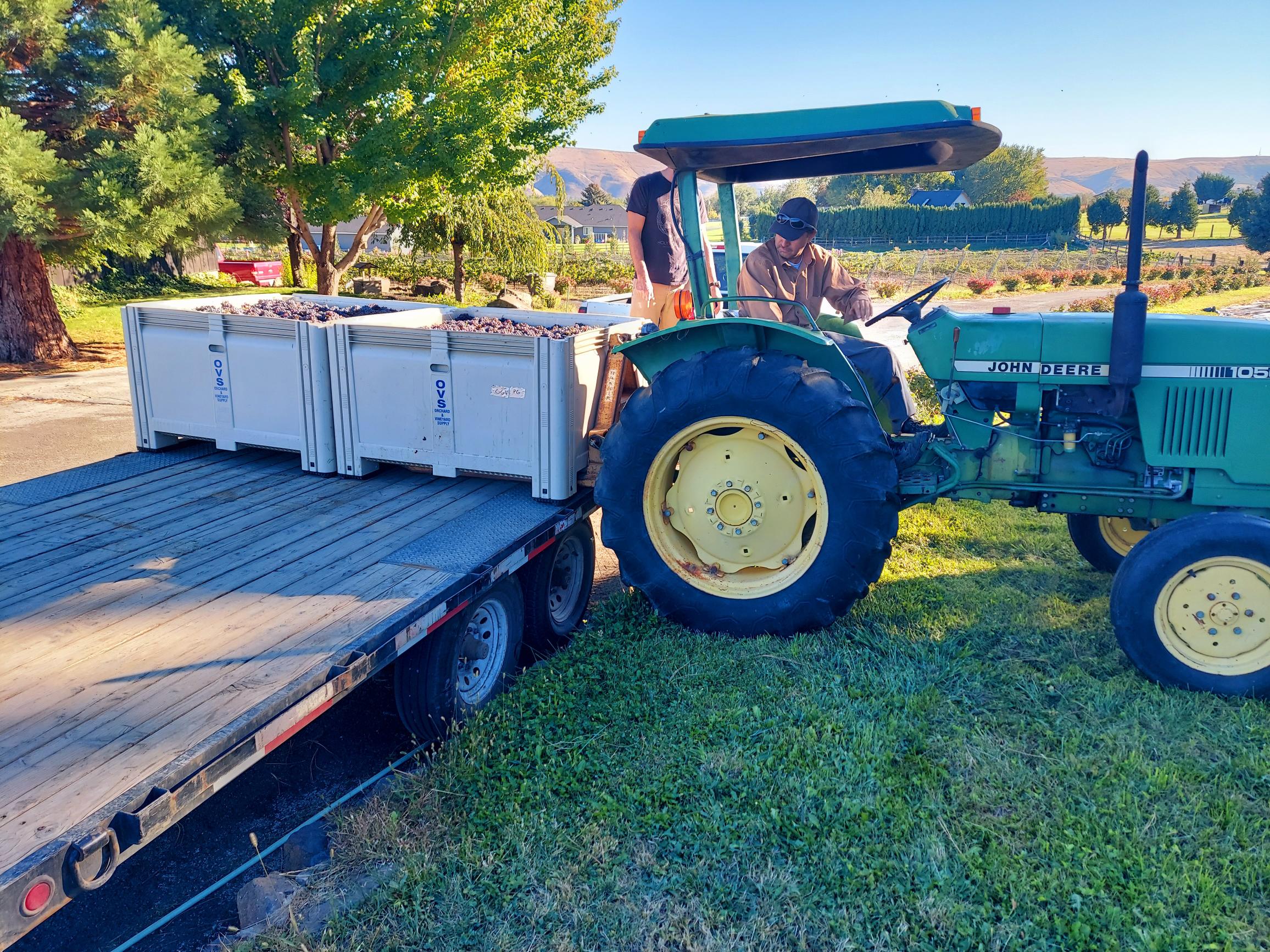
WW: What led into the progression of farming grapes? Is this the first time with grapes or did you do that in Goldendale as well?
Jay: The sum of my 40 years of farming and engineering is being poured into the Selah Vineyard. Farming grapes at this level is expensive. Particularly when you start with a 100-year-old cattle reach.
The first trick was finding a place that had an adequate water supply, ideal soil profiles, long sunny growing seasons. And, most importantly, a location that was at an elevation to withstand some of the harsh realities of climate change. Once we check all those boxes we signed on the dotted line. The farming I’ve done has been focused on sustainability including the vineyard. The plants at the vineyard have been managed organically. The Selah Vineyard planning and development has not happened by itself. We retained a profession plant manager and a viticulturist. They have been invaluable to us over the past seven years.
Outside of my younger life experiences I’ve never grown grapes. My progression toward farming grapes is rooted in my childhood. It also rooted in my efforts to challenge this society and, in turn the wine industry to recognize that there is a Black market out there that has 1.2 trillion dollars’ worth of buying power. So, a little yes and a big no to your question about first time farming grapes.
The sum of my 40 years of farming and engineering is being poured into the Selah Vineyard.—Jay Itote
WW: How would you describe your philosophy in the vines?
Jay: My philosophical approach is all about producing a quality product in whatever the calling may be. I approach being a vintner as I do working on a 200-million-dollar engineering project or, as I did in making tea sandwiches for my mom as a preteen. It’s all about the foundational elements and are they there to do what it takes to produce a quality product.
Our philosophy behind selecting varietals also sprung from the influence of pervious agriculture endeavors in Goldendale and our 400 acres farm/plantation in Belize, Central America. The drive toward excellence and quality at the vineyard is paramount. Our varietals run the gambit and entails a degree of risk for novice vintners like us. Our Austrian Zweigelt and French Pinot Meunier were two big risks that are starting to pay off.
Personally, I believe that my family come from a pedigree that in the right environment we’ll excel in whatever we do. The truth is that my parents took a great deal of risk in their time. My brother the baker owned five or six bakeries and was known in New Jersey as the “The King of Cinnamon Buns.” His son, Kevin Spraga, won Top Chef America during its seventh season. My daughters in Australia have excelled. One is the chief editor of a national magazine. The next one won the top emerging fashion designer about ten years ago and the youngest is the chef for a billionaire in Hawaii. The trick is to create the foundation to support your goals. At times it may looks messy and taking risk can wear you down, but the rewards are great no matter the outcomes.
Our brand can be summed up as Organic Minimalist. We want to give our customers base what the earth gave the fruit. Nothing fancy, no tricks, nothing to unmind your well-being. Our wines are light bodied with ABV are between 11.5% to 13.4%.
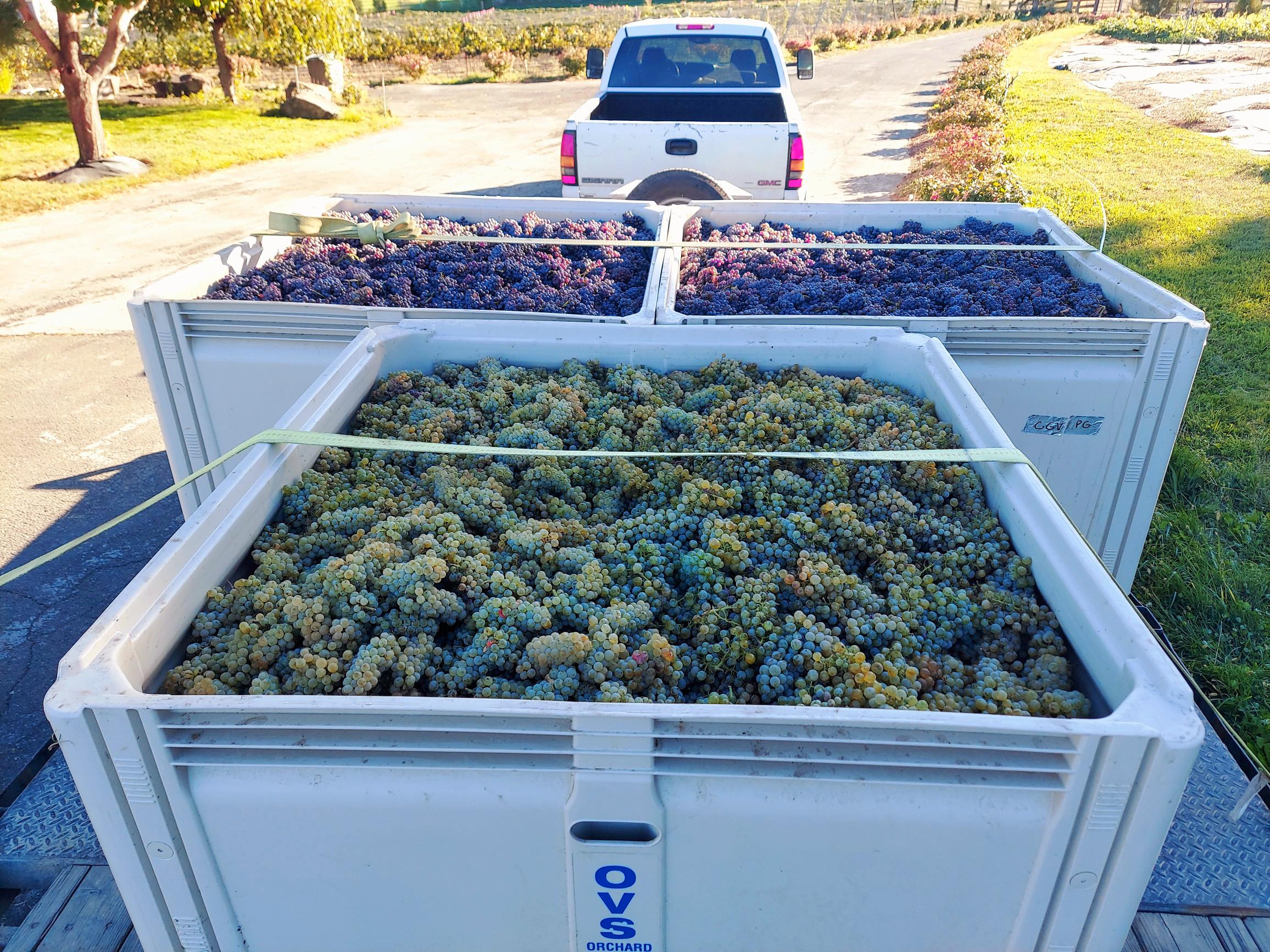
WW: How did you go from civil engineering to this deep connection with the outdoors and working in the ground?
Jay: I ended up in Seattle after being hired by one of the first African American engineering companies in American. I was 25 and my maiden project was to develop a set of plans and specification for the City of Seattle that would retire the Rainier Treatment Plant and run the effluence to the then-new West Point Treatment Plant. The owners of the firm were Ken Mathis PE and Fred E. Jordan PE, who were and are professional licensed engineers and entrepreneurs. Ken and Fred were also my mentors. Their firm was like working at the UN with Engineers and technical staff from all over the world.
But back to your question. Civil engineering is about conceiving designs to build, supervise, operate, construct, and maintain infrastructure projects and systems. Including roads, building airport, tunnels, dams, bridges and systems for water supply and sewage treatment. Farming entails many of these disciplines.
The outdoor aspect of this question started in scouting. I was a Cub Scout, Boy Scout and Sea Scout as I worked my way through adolescence. By the time I arrived in Seattle the adventures of the outdoors were well entrenched in my DNA. Then there was the Jim Whitaker and REI factor. Back then you could still find Mr. Whittaker working in his flagship store. As far as I was concerned, REI was like walking into the Gucci’s of outdoor equipment. In fact, maybe the wine industry should take a page from the REI or North Face marketing playbook. The advance of Black Hip Hop music was ushered in with parkas, down clothing, mountain boots, and high-end apparel being worn by the likes of Tupac, Queen Latifa and Puffy. I’m not sure if Tupac drank wine but I know Snoop Dog does. The market is there waiting.
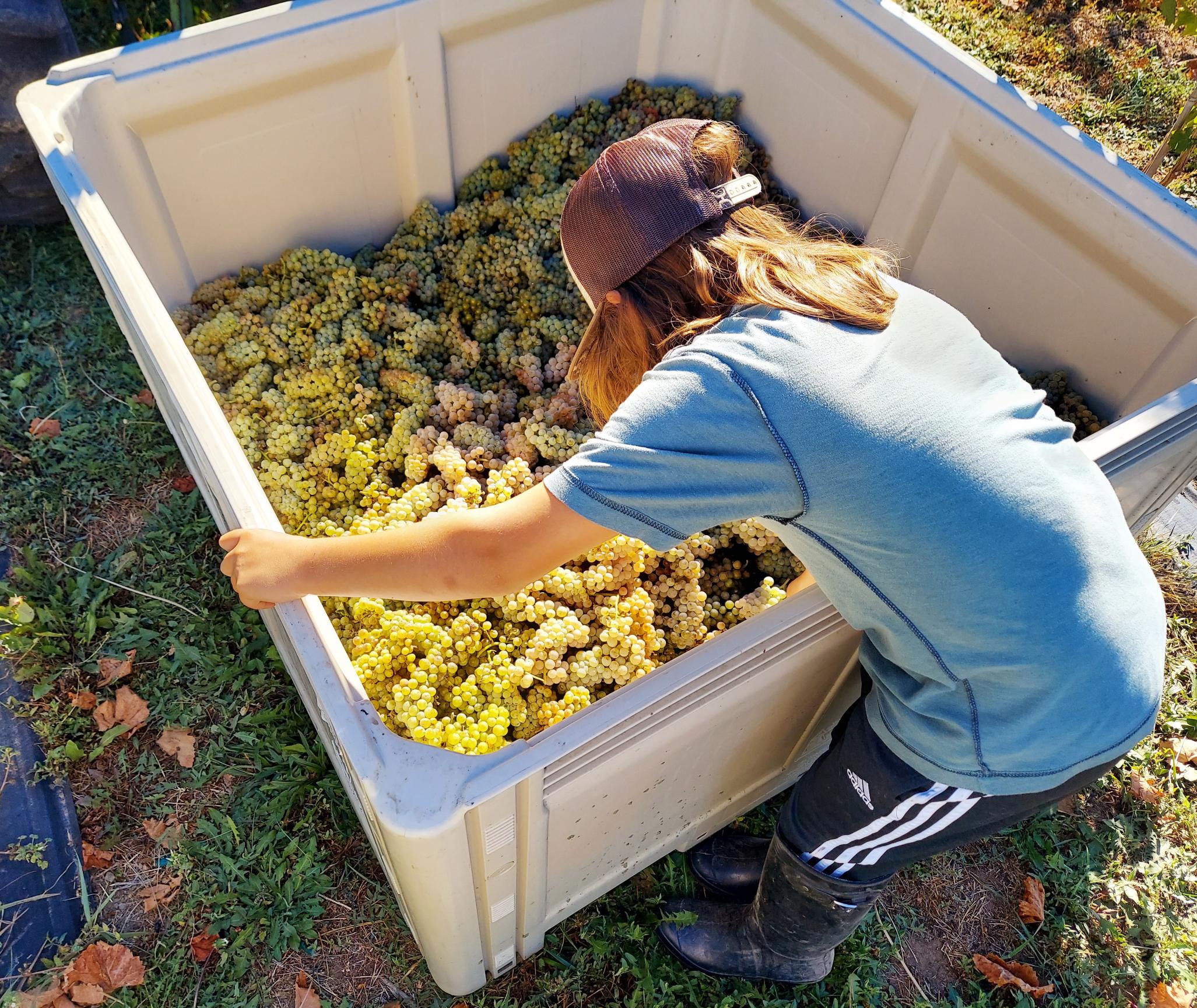
WW: Tell me a little bit about like what you grow at the vineyard.
Jay: We’ve had plants in the ground since 2016, when we put down our first blocks. I didn’t hide the fact that this is my first rodeo growing grapes, even though I had that little bit of experience as a child with our arbor. But I don’t profess what I don’t know. I don’t get out there and act like I know about being a vintner. It’s much more my style to say, “I’m new at this, I’m going to need some help.” I can learn how to be a vintner. And that’s what we’ve been doing for the past seven years.
Our knowledgeable viticulturist developed a list of what he thought he would grow on this land. We took in consideration the property latitude. soil types, topography, water source and vectors as part of our analysis in selection of our varietals. Our soil reports done before we purchased the property came back as “Optimal” for the varietals we wanted to plant and grow. I guess it’s the 100+ years of cattle fertilizer in the soil. We consider ourselves a boutique vineyard with the intent to sell grapes for blending but also varietals that can stand on their own with quality. We have been the most successful with our Pinot Meunier, Pinot Noir, Chardonnay, Pinot Gris and Zweigelt. We also have blocks of Merlot, Cabernet Sauvignon and Cabernet Franc that are ready to produce tonnage hopefully during our 2022 harvest. In 2020 we took five varietals and had them custom crushed at a local winery. We plan to offer them through our wine club soon. As I’ve indicated before, we managed them organically.
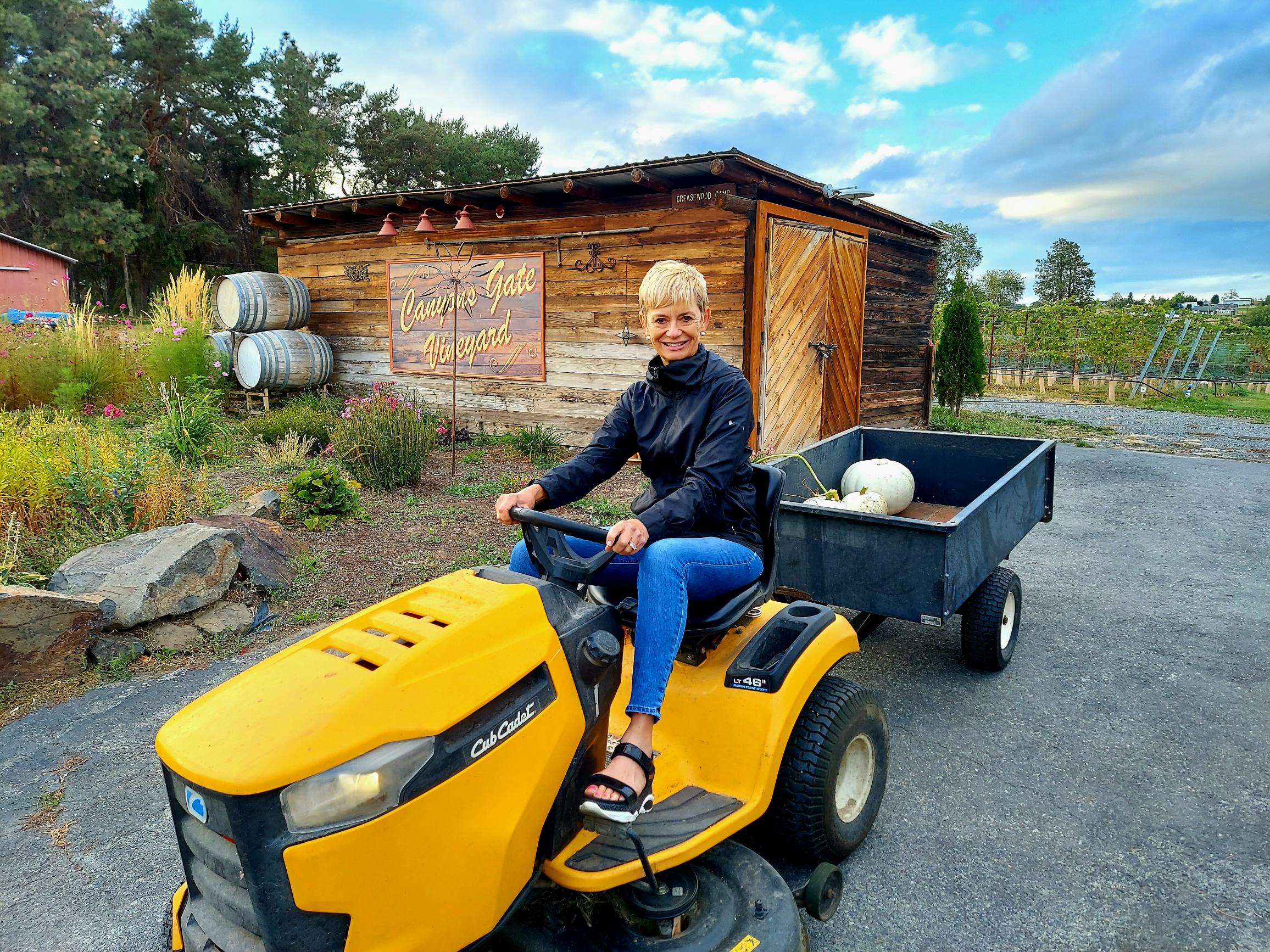
Not all of our acreage is planted with grapes. We spent the past five years watching what varietals would grow here. During the first three years, we fenced off the vineyard from the pastureland because the previous owner had leased out the pasture to a local rancher when we closed on the property. She asked us if we would do her a favor and continue the lease until the it ran out. We honored that promise for three years until a neighbor’s bull wandered into our young vineyard footprint. It was the equivalent of a bull in the China Shop. But miracles do happen. For some reason, he walked around the plants and through the vineyards without causing damage, and we were able to usher him back to where he belonged.
I didn’t hide the fact that this was my first rodeo growing grapes.—Jay Itote
WW: What an image. Maybe we’ve misunderstood the bull all this time.
Jay: Exactly. That’s how we felt in the end. The truth of the matter is that the bull was just as confused as we were. Whatever it was looking for the vines in front of him were not it. We had a situation that really could have gotten out of hand. It actually took crowd control because our crew started to charge in which would have really been bad. I had to calm them down first then organized then to move in gently to get that beast back to the neighbor’s property.
Many folks around here think I’m just a city slicker. There was a rumor going around that my partner and I were wealthy Silicon Valley folks. Neither one of us likes Silicon Valley. I mean, it’s not a place I would want to live even though I had worked there on engineering projects. I had to nip that rumor in the bud. The person who started this rumor wasn’t speaking from malice. I had mentioned to several folks around that I had worked there, and they just assumed we were rich. In fact, we are just hard-working people. This perception had some county folk thinking they can pull a fast one on me in particularly. Some of the stuff that comes my way makes it hard for me to separate it from stereotyping of Black folks or just plain dark heartedness coming from jealousy or envy. I can’t tell you how many folks have said to me that I’m living their dream as I stand knee deep in mud from a broken irrigation line. I have become weary of folks who say stuff like that to me and we’ve just met. In a way, I’m quite like that bull we moved out of the vineyard that day. Show some respect, tread lightly, and don’t judge a book by its cover.
Life is short, you know. There are the hills and valleys, and we must pass through them with a sense of service to others along the way. Our work here is not all about grapes.
There are the hills and valleys, and we must pass through them with a sense of service to others along the way. Our work here is not all about grapes.—Jay Itote
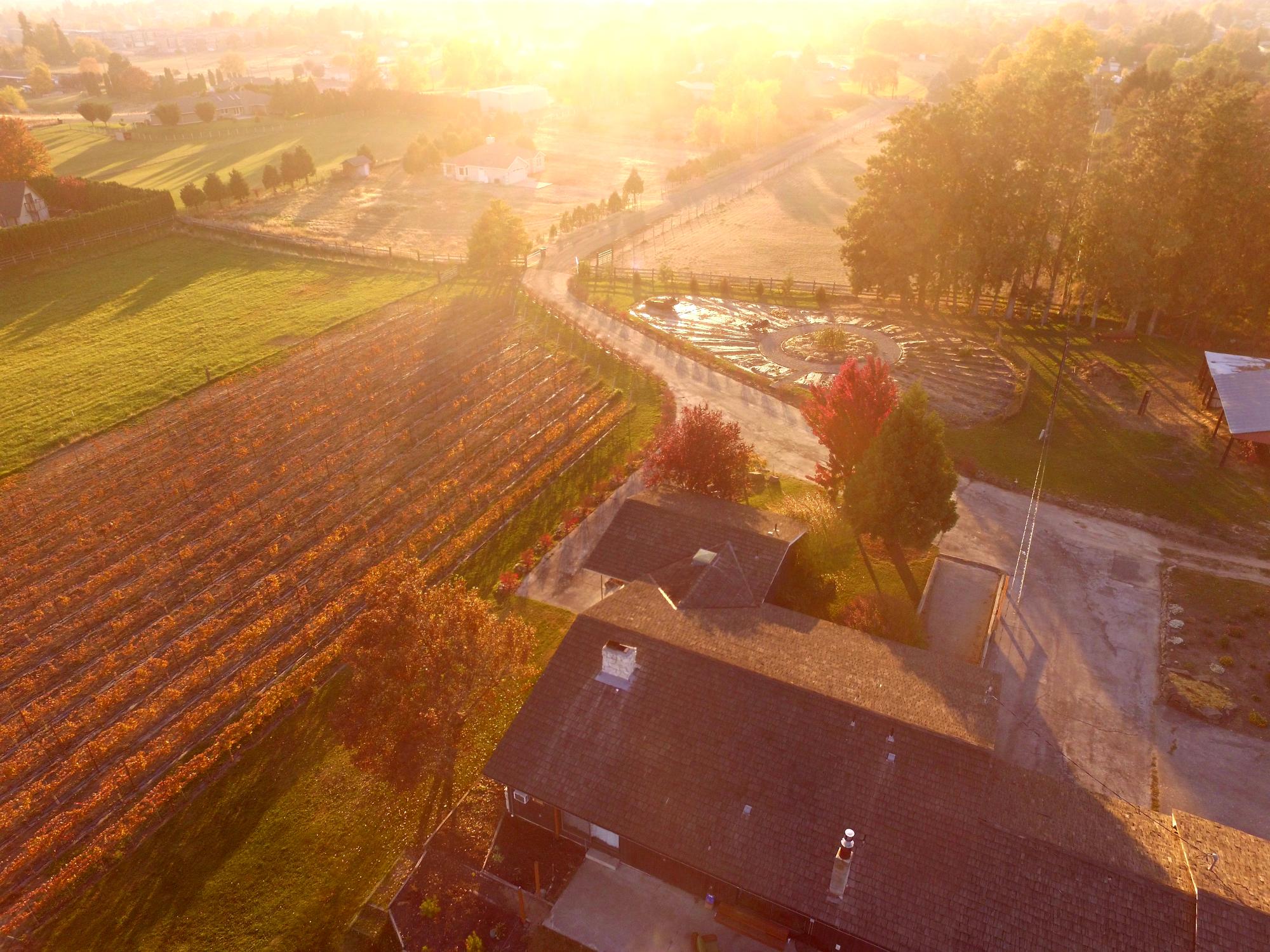
WW: You mentioned that some of the work you do is in putting voice to the history of African Americans in agrarian societies. What does this work look like to you?
Jay: Over my career, I’ve mentored my share of young folks. Many of the projects I’ve worked on have mentoring programs that I’ve been a part of or lead them. I try to give them a sense of duty to the greater purpose to humanity. Like, can you—once you reach that dream place of your—design that or manage this in an equitable way that includes and respect the impacted communities? Or, are you considering the full range of skills available from small business that could play a part in a project that you run. And, as you trod alone, “don’t burn bridges,” if that’s at all possible.
Many of the African American students that have crossed my path, I’ve tried to give them a frame of historical reference of, “If you don’t know where you’ve come from, you don’t know where you’re going,” which is from Maya Angelou. Many have never heard of George Washington Carver, the great American Agriculture Scientist and Inventor, or Marie Van Brittan Brown, who filed a patent in 1966 for the first-ever home security system. Or that agrarian societies intensification of agriculture began in Mesopotamian Sumer, Egypt, Africa in general. Many farmers, black and white, don’t know that at the turn of the 20th century, there were about a million black farmers in the United States. In 2017, that number was about 48,000. Part of what I relay to these young folks is about the funding available to start building a sustain foundation no matter what your goals are. I also try to instill in them to please don’t forget to “Pay It Forward” as you trod alone in life.
WW: A final, random question: what is your favorite non-musical sound?
Jay: Whoa. Non-musical sounds? The wind blowing. I’m getting choked up trying to talk about this. But the wind blowing on a warm summer night will do it for me. Walking down a path and hearing the leaves rustling under my feet or from the trees. I love the sounds of the wind at beaches. Contact with the grass and earth is big for me. On my last trip to visit my grandson in Australia, I spent lots of time rolling around the ground with him just about everywhere we went. I guess I’m what you would call a cheap date.
I’m getting choked up trying to talk about this. But the wind blowing on a warm summer night will do it for me.—Jay Itote, Canyons Gate Vineyard
Traducido por Melany Meza
Washington Wine: Cuéntame un poco sobre quién eres, y cómo llegaste a donde estás ahora mismo.
Jay Itote: Bueno, de profesión soy ingeniero civil de la construcción. He estado haciendo eso durante unos 40 años. Soy originario de West Chester, Pensilvania, que es un pequeño pueblo que se encuentra al final de lo que se llama la Línea Principal al Suroeste de Philadelphia.
West Chester fue el epicentro del ferrocarril subterráneo durante la esclavitud. No estoy seguro de lo que la conexión es, pero hay una línea en la película “Harriet” en la que Harriet Tubman está siendo contada por un cuáquero negro para formar una familia con el apellido de nuestra familia. Durante mi niñez y hasta hoy, éramos la única familia en el área con ese nombre. De niños, jugábamos en sitios donde esclavos habían buscado refugio hasta que serían transferidos al siguiente conductor en un esfuerzo por avanzar más hacia el norte. Ese pueblito era muy rico en historia americana. Fueron 15 millas de la línea Mason Dixon la división del norte y el sur. Mucha gente no lo sabe pero Pennsylvania es en realidad la separación del norte y el sur, principalmente porque tiene 125 millas al norte de Washington DC.
Crecí en una casa colonial de ladrillo de tres pisos adjunta que tenía un marcador de piedra insertado entre el bordillo de granito y la acera de ladrillo rojo que decía: “El general Lafayette habló con sus tropas aquí en el año 1812.” Al crecer, interactúe con cuáqueros, amish y menonitas. La mayoría vivía en haciendas en comunidades aledañas. Asistí a las Escuelas Bíblicas Menonitas en el verano. El Oeste, Chester y la historia de esa zona de Pensilvania han tenido una profunda influencia en mí. El Ferrocarril Subterráneo y el movimiento abolicionista dieron forma a mi concisión de justicia social. Nuestra ciudad era bien conocida como un lugar de basura para los esclavos.
Cuando era niño, veía a gente como Pearl S. Buck, la escritora y novelista de este pueblo de 11.000 habitantes. gente. La Sra. Buck recibió el Premio Nobel de Literatura en 1938 por Good Earth. Mi madre me informó que la Sra. Buck vivía en New Hope, Bucks County, pero frecuentaba West, Chester debido a familiares y amigos. El artista Andrew Wyatt, a quien conocí y fotografié. La oficina de correos de Chadds Ford cuando era adolescente, fue muy amable conmigo cada vez que cruzaba nuestros caminos. Claude Rains, el actor que interpretó en Casa Blanca y Lawrence de Arabia vivió desde una cuadra de mi casa. Samuel Barber, el pianista clásico de renombre mundial, vivía a tiro de piedra de nuestro patio trasero. Byard Rustin, el hombre que organizó la Marcha de MLK en Washington, solía Aparece en la barbería propiedad de su hermano Earl, mi peluquero de la infancia.
Mi madre era la luz que me guiaba y me informaba sobre quiénes eran estas personas, dónde y cómo hizo en su vida. Ella también fue quien me enseñó sobre cocina. Mi madre y mi padre tenían una pequeña negocio de catering. A menudo se me podía encontrar haciendo sándwiches de té y hors d’oeuvre. Después de un evento, mi madre traía a casa alimentos extraños como saltamontes cubiertos de chocolate, hormigas, y otros insectos. Para un niño afroamericano de 11 años, estas experiencias ayudaron a moldear mi entendimiento sobre América y mi lugar aquí.
Mi madre era la luz que me guiaba y me informaba sobre quiénes eran estas personas, dónde y cómo hizo en su vida. Ella también fue quien me enseñó sobre cocina.—Jay Itote
Mi padre tuvo la mayor influencia sobre mí con respecto a la agricultura. Trabajó los 7 días de la semana para la mayoría de la época en que yo estaba creciendo. Trabajó 5 días en el Hospital del Ejército Valley Forge de 3,000 camas en el servicio de comida. Cuando se jubiló, era el Superintendente del Servicio de Alimentos. Los otros dos días, trabajó en uno de los primeros ranchos Black Angus en el noreste. Este rancho estaba cerca de Gettysburg, PA. Les puedo decir que cuando era niño y adolescente vi muchos paisajes de Andrew Wyatt en tiempo real deambulando por el condado con mi padre. Mi primera experiencia agrícola ocurrió en ese rancho Angus. El dueño permitió que mi padre y otros peones del rancho sembraran cultivos en hileras en unas dos hectáreas. Durante este período, conocí por primera vez las uvas. A la edad de unos nueve años mi padre instaló una parra de 20’x 30′ en nuestro patio trasero. No recuerdo la variedad, pero era una uva de vino blanco que podía sobrevivir a los duros inviernos de la costa este. Ese Arbor se convirtió en el centro de todas las reuniones familiares de verano después de su finalización.
Ahora, en 2022, estoy en mi tercera finca con Canyons Gate Vineyard en Selah, WA. La empresa agrícola/ganadero se llevó a cabo en Goldendale, WA, que está a unas 60 millas del viñedo. En el pasado, y hasta donde yo sabía, yo era el único hombre negro en todo el condado de Klickitat.

WW: ¿Cómo fue o es eso? ¿Ser uno de los pocos granjeros negros?
Jay: Ha sido muy interesante estar en ese espacio. La agricultura en cualquier nivel es un trabajo duro sea cual sea raza eres ya sea en Selah, Goldendale o Belice América Central. Mis vecinos vieron que yo era un trabajador incansable en cualquier clima o situación y que cuando las actitudes comenzaron a cambiar oportunidad. No es la actitud de todos, pero lo suficiente como para sentirme cómodo en mi propia piel.
Gente de la mayoría, gueros en general y particularmente en las regiones agrícolas no han tenido experiencia de estar cerca de África estadounidenses en cualquier nivel. Incluso hoy en día, hay tantos estereotipos y energía negativa que crea un muro de miedo que impide la buena voluntad y la comunicación entre las personas de todas las razas. Dicho esto, tengo muy buenos recuerdos de Goldendale, y me fui de allí con un sentido que la mayoría de las personas en Goldendale eran personas de buen corazón y que estarían ahí para usted cuando sea necesario. Realmente sentí que Goldendale era uno de los mejores lugares en los que he vivido. Viviendo allí me presentó a Yakima y Selah, donde viajaría quincenalmente con Status Pass para comprar equipo y suministros.
En Goldendale, estaba ocupando una casa. Aprendiendo mis habilidades todos los días. Cometer errores pero aprender de ellos también. Mi mejor recuerdo fue construir una pequeña cabaña allí con una motosierra. Al final, solo había media pulgada de ciruela en esa estructura. Antes de construir la cabaña construí un corral con estaciones de alimentación y puntales para mis 36 cabras. Una vez pude sacar agua en un arroyo de temporada, sembré cebada, centeno, avena, girasoles, alfalfa, amaranto y quinua orgánicos. Muchos de los granos que ve son comunes en el mercado hoy en día.
En ese momento, estaba al tanto de los subsidios agrícolas disponibles para los pequeños agricultores de la zona. Sin embargo, el USDA local no estaba allí para los agricultores negros. Es mi opinión, pero el USDA en ese momento no podía envolver su cabeza en el concepto de agricultores afroamericanos al menos en la costa oeste. Unos 20 años después de mis aventuras en Goldendale, el USDA resolvió una demanda colectiva con agricultores afroamericanos y nativos americanos por mil millones de dólares cada uno por base y en esencia roja que los recubre. Hoy, con la viña estamos trabajando con el USDA para tomar aprovechar sus programas de conservación y sostenibilidad. Nuestro objetivo es proteger lo que hay, sino también desarrollar tantos flujos de ingresos como sea posible mientras se considera el impacto en hábitat y las comunidades humanas. Estamos buscando asistencia técnica y financiera de los locales de USDA.. Hasta ahora, estar en este espacio ha sido bueno. En todo el sistema, los problemas que surgen en su cabeza es la falta de diversidad dentro de las filas de la infraestructura regional del USDA. Me encantaría ver más contrataciones de diversos grupos.
Después de 7 años en Goldendale, partí del Noroeste para dedicarme a la agricultura y la ingeniería en Belice, América Central. Goldendale era lo que yo quería que fuera: una herramienta de aprendizaje.
En el pasado, y hasta donde yo sabía, yo era el único hombre negro en todo el condado de Klickitat.—Jay Itote

WW: ¿Que condujo a la progresión del cultivo de uvas? ¿Es esta la primera vez con uvas o lo hizo también en Goldendale?
Jay: Entre mis 40 años de agricultura e ingeniería se vierte en el viñedo Selah. Cultivar uvas a este nivel es caro. Particularmente cuando comienzas con un ganado de 100 años puedes alcanzar.
El primer truco fue encontrar un lugar que tuviera un suministro de agua adecuado, perfiles de suelo ideales, largas temporadas de crecimiento soleado. Y, lo más importante, una ubicación que estaba a una altura para soportar algunas de las duras realidades del cambio climático. Una vez que marcamos todas esas casillas, firmamos en el línea punteada. El cultivo que he hecho se ha centrado en la sostenibilidad, incluido el viñedo. Las plantas en el viñedo se han manejado orgánicamente. La planificación del viñedo Selah y el desarrollo no ha ocurrido por sí mismo. Los viticultores han sido invaluables para nosotros durante los últimos siete años.
Fuera de mis experiencias de vida más joven, nunca he cultivado uvas. Mi progresión hacia la agricultura tiene sus raíces en mi infancia. También arraigó en mis esfuerzos por desafiar a esta sociedad y, en hacer que la industria del vino reconozca que existe un mercado negro que tiene 1.2 billones de dólares de poder adquisitivo. Entonces, un pequeño sí y un gran no a tu pregunta sobre la primera vez cultivo de uvas.
Entre mis 40 años de agricultura e ingeniería se vierte en el viñedo Selah.—Jay Itote
WW: ¿Cómo describirías tu filosofía en las vides?
Jay: Mi enfoque filosófico trata de producir un producto de calidad en cualquier vocación. Me acerco a ser viticultor como lo hago trabajando en un proyecto de ingeniería de 200 millones de dólares o, como lo hice al hacer sándwiches de té para mi madre cuando era preadolescente. Se trata de lo fundamental elementos y están ahí para hacer lo necesario para producir un producto de calidad.
Nuestra filosofía detrás de la selección de variedades también surgió de la influencia de la agricultura permeable esfuerzos en Goldendale y nuestra finca/plantación de 400 acres en Belice, América Central. El impulso hacia la excelencia y la calidad en el viñedo es primordial. Nuestras variedades corren el gambito y conlleva un grado de riesgo para los viticultores novatos como nosotros. Nuestro Zweigelt austríaco y Pinot francés Meunier eran dos grandes riesgos que empiezan a dar sus frutos.
Personalmente, creo que mi familia viene de un pedigrí que en el entorno adecuado se destaca en todo lo que hacemos. La verdad es esa, mis padres se arriesgaron mucho en su época. Mi hermano el panadero tenía 5 o 6 panaderías y era conocido en Nueva Jersey como el “Rey de los bollos de canela.” Su hijo, Kevin Spraga, ganó Top Chef America durante su séptima temporada. Mis hijas en Australia se han destacado. Uno es el jefe de redacción de una revista nacional. El siguiente ganó el mejor diseñador de moda emergente sobre hace diez años y el más joven es el chef de un multimillonario en Hawai. El truco es crear la base para apoyar sus objetivos. A veces puede parecer desordenado y correr riesgos puede desgastarlo, pero las recompensas son excelentes sin importar los resultados.
Nuestra marca se puede resumir como minimalista orgánico. Queremos que nuestros clientes se basen en lo que la tierra dio el fruto. Nada lujoso, sin trucos, nada que despreocupe su bienestar. Nuestros vinos son ligeros corporales con ABV están entre 11. 5% a 13.4%.

WW: ¿Cómo pasaste de la ingeniería civil a esta profunda conexión con el aire libre y trabajando en el suelo?
Jay: Terminé en Seattle después de ser contratado por uno de los primeros ingenieros afroamericanos en empresas en América. Tenía 25 años y mi primer proyecto era desarrollar un conjunto de planes y especificaciones para la Ciudad de Seattle que retiraría la Planta de Tratamiento Rainier y operaría la efluente a la entonces nueva Planta de Tratamiento de West Point. Los dueños de la firma eran Ken Mathis. PE y Fred E. Jordan PE, quienes fueron ingenieros y empresarios profesionales con licencia. Ken y Fred también fueron mis mentores. Su empresa era como trabajar en la ONU con ingenieros y personal técnico de todo el mundo.
Pero volviendo a su pregunta. La ingeniería civil consiste en concebir diseños para construir, supervisar, operar, construir y mantener proyectos y sistemas de infraestructura. Incluidas las carreteras, la construcción del aeropuerto, túneles, presas, puentes y sistemas de abastecimiento de agua y tratamiento de aguas residuales. La agricultura implica muchas de estas disciplinas.
El aspecto exterior de esta pregunta comenzó en la exploración. Fui Cub Scout, Boy Scout y Sea Scout mientras trabajaba en mi camino de adolescentes. Cuando llegué a Seattle, las aventuras al aire libre estaban bien en trance en mi ADN. Luego estaba el factor Jim Whitaker y REI. En ese entonces, todavía podías encontrar al Sr. Whittaker trabajando en su tienda insignia. en lo que yo estaba preocupada, REI fue como entrar en el Gucci de equipos para exteriores. De hecho, tal vez la industria del vino debería sacar una página del manual de marketing de REI o North Face. La música Black Hip Hop se introdujo con parkas, ropa de plumas, botas de montaña y ropa de alta gama. Ropa usada por gente como Tupac, Queen Latifa y Puffy. No estoy seguro si Tupac bebió vino, pero sé que Snoop Dog sí. El mercado está ahí esperando.

WW: Cuéntame un poco sobre lo que cultivas en el viñedo.
Jay: Tenemos plantas en el suelo desde 2016, cuando colocamos nuestros primeros bloques. No me escondí el hecho de que este es mi primer rodeo cultivando uvas, a pesar de que tenía un poco de experiencia como un niño con nuestro cenador. Pero no profeso lo que no sé. No salgo y actúo como Sé acerca de ser un viticultor. Es mucho más mi estilo decir: “Soy nuevo en esto, voy a necesitar un poco de ayuda.” Puedes aprender cómo ser un viticultor. Y eso es lo que hemos estado haciendo durante los últimos siete años.
Nuestro viticultor experto desarrolló una lista de lo que pensó que crecería en esta tierra. Tomamos en consideración la latitud de la propiedad. tipos de suelo, topografía, fuente de agua y vector medicación como parte de nuestro análisis en la selección de nuestros varietales. Nuestros informes de suelo hechos antes de que nosotros compramos la propiedad puede volver a ser “Óptima” para las variedades que queríamos plantar y cultivar. Supongo que son más de 100 años de fertilizante para ganado en el suelo. Nos consideramos una boutique viñedo con la intención de vender uvas para mezclar, pero también variedades que puedan valerse por sí mismas. Con calidad hemos sido los más exitosos con nuestro Pinot Meunier, Pinot Noir, Chardonnay, Pinot Gris y Zweigelt. También contamos con bloques de Merlot, Cabernet Sauvignon y Cabernet Franco que están listos para producir tonelaje con suerte durante nuestra cosecha 2022. En 2020 llevamos cinco varietales y los trituraron a medida en una bodega local. Pensamos ofrecerlos a través de nuestro vino club pronto. Como he indicado antes, los gestionamos de forma orgánica.

No toda nuestra superficie cultivada está plantada con uvas. Pasamos los últimos cinco años viendo que las variedades crecerían aquí. Durante los primeros tres años, estuvieron cercanos a la viña de la pastizales porque el propietario anterior había arrendado los pastizales a un ganadero local cuando cerró la propiedad. Ella nos pregunta si le haríamos un favor y continuaremos con el contrato de arrendamiento hasta que finalice. Se acabó. Cumplimos esa promesa durante tres años hasta que el toro de un vecino entró en nuestra huella de viñedo joven. Era el equivalente a un toro en la China Shop. Pero los milagros hacen suceder. Por alguna razón, anduvo entre las plantas y entre los viñedos sin causando daño, y pudimos llevarlo de regreso a donde pertenecía.
No me escondí el hecho de que este es mi primer rodeo cultivando uvas.—Jay Itote
WW: Vaya, qué imagen. Tal vez hemos entendido mal el toro todo este tiempo.
Jay: Exacto. Así es como nos sentimos al final. La verdad es que el toro era igual de confundidos como estábamos. Lo que sea que estaba buscando en las enredaderas frente a él, ¿no es así? Teníamos una situación que realmente podría haberse salido de control. De hecho, tomó el control de la multitud porque nuestro la tripulación comenzó a cargar en lo que hubiera sido realmente malo. Tenía que calmarse primero y luego organizado entonces para moverse suavemente para llevar a esa bestia de regreso a la propiedad del vecino.
Mucha gente por aquí piensa que solo soy un urbanita. Corría el rumor de que mi socio y yo éramos gente rica de Silicon Valley. A ninguno de nosotros le gusta Silicon Valley. Quiero decir, no es un lugar en el que me gustaría vivir a pesar de que había trabajado allí en proyectos de ingeniería. Tuve que corta ese rumor de raíz. La persona que inició este rumor no hablaba con malicia. Había mencionado a varias personas que habían trabajado allí, y simplemente asumieron que éramos ricos. De hecho, solo somos personas trabajadoras. Esta percepción hizo que algunas personas del condado pensaran que ellos pueden sacar una rápida en mí en particular. Algunas de las cosas que se cruzan en mi camino lo hacen difícil para que yo lo separe de los estereotipos de los negros o simplemente del corazón oscuro que proviene de celos o envidia. No puedo decirle cuántas personas me han dicho que estoy viviendo su sueño como yo pararse hasta las rodillas en el lodo de una línea de riego rota. Me he cansado de la gente que dice cosas así para mí y nos acabamos de conocer. En cierto modo, soy bastante como ese toro que sacamos de la viña ese día. Muestre algo de respeto, pise con cuidado y no juzgue un libro por su portada.
La vida es corta, ya sabes. Están las colinas y los valles, y debemos atravesarlos con un sentido de servicio a los demás en el camino. Nuestro trabajo aquí no se trata solo de uvas.
Están las colinas y los valles, y debemos atravesarlos con un sentido de servicio a los demás en el camino. Nuestro trabajo aquí no se trata solo de uvas.—Jay Itote

WW: Mencionaste que parte del trabajo que haces es ponerle voz a la historia de los afroamericanos en las sociedades agrarias. ¿Qué te parece este trabajo?
Jay: A lo largo de mi carrera, he sido mentor de muchos jóvenes. Muchos de los proyectos en los que he trabajado. Tengo programas de tutoría de los que he sido parte o los dirijo. Durante los últimos 20 años, la mayoría de mis aprendices son de ascendencia asiática. Son estudiantes muy inteligentes. Sin embargo, carece de propósito fuera de ganar dinero. Intento darles un sentido del deber hacia el mayor propósito para la humanidad. Como, ¿puedes, una vez que llegues a ese lugar de tus sueños, diseñar ese o gestionar esto de una manera equitativa que incluya y respete a las comunidades afectadas? O son considerando la gama completa de habilidades disponibles de las pequeñas empresas que podrían desempeñar un papel en un proyecto que ejecuta. Y, mientras camina solo, “no queme los puentes” si eso es posible.
Muchos de los estudiantes afroamericanos que se han cruzado en mi camino, he tratado de darles un marco de referencia histórica. Se trata más de: “Si no sabes de dónde vienes, no saber a dónde vas”, que es de Maya Angelou. Muchos nunca han oído hablar de George Washington Carver, el gran inventor agrícola estadounidense, o Marie Van Brittan Brown, quien presentó una patente en 1966 para el primer sistema de seguridad para el hogar. La intensificación de la agricultura se inició en Mesopotamia, Sumeria, Egipto, África en general. Muchos agricultores, blancos y negros, no saben que a principios del siglo XX había alrededor de un millón de granjeros negros en los Estados Unidos. En 2017, ese número era de unos 48.000. Parte de lo que les transmito a estos jóvenes es sobre los fondos disponibles para comenzar a construir un base sin importar cuáles sean sus objetivos. También trato de inculcarles que por favor no se olviden de “Pay It Forward” mientras andabas solo en la vida.
WW: Una última pregunta: ¿cuál es tu sonido no musical favorito?
Jay: Vaya. ¿Sonidos no musicales?
WW: Sí.
Jay: El viento sopla. Me estoy ahogando tratando de hablar de esto. Pero el viento que sopla en una cálida noche de verano lo hará por mí. Caminar por un sendero y escuchar el susurro de las hojas bajo mis pies o de los árboles. Me encantan los sonidos del viento en las playas. Contacto con la hierba y la tierra es grande para mí. En mi último viaje para visitar a mi nieto en Australia, pasé mucho tiempo rodando por el suelo con él en casi todos los lugares a los que íbamos. Supongo que soy lo que tu dirías una cita barata.
Me estoy ahogando tratando de hablar de esto. Pero el viento que sopla en una cálida noche de verano lo hará por mí.—Jay Itote, Canyons Gate Vineyard
